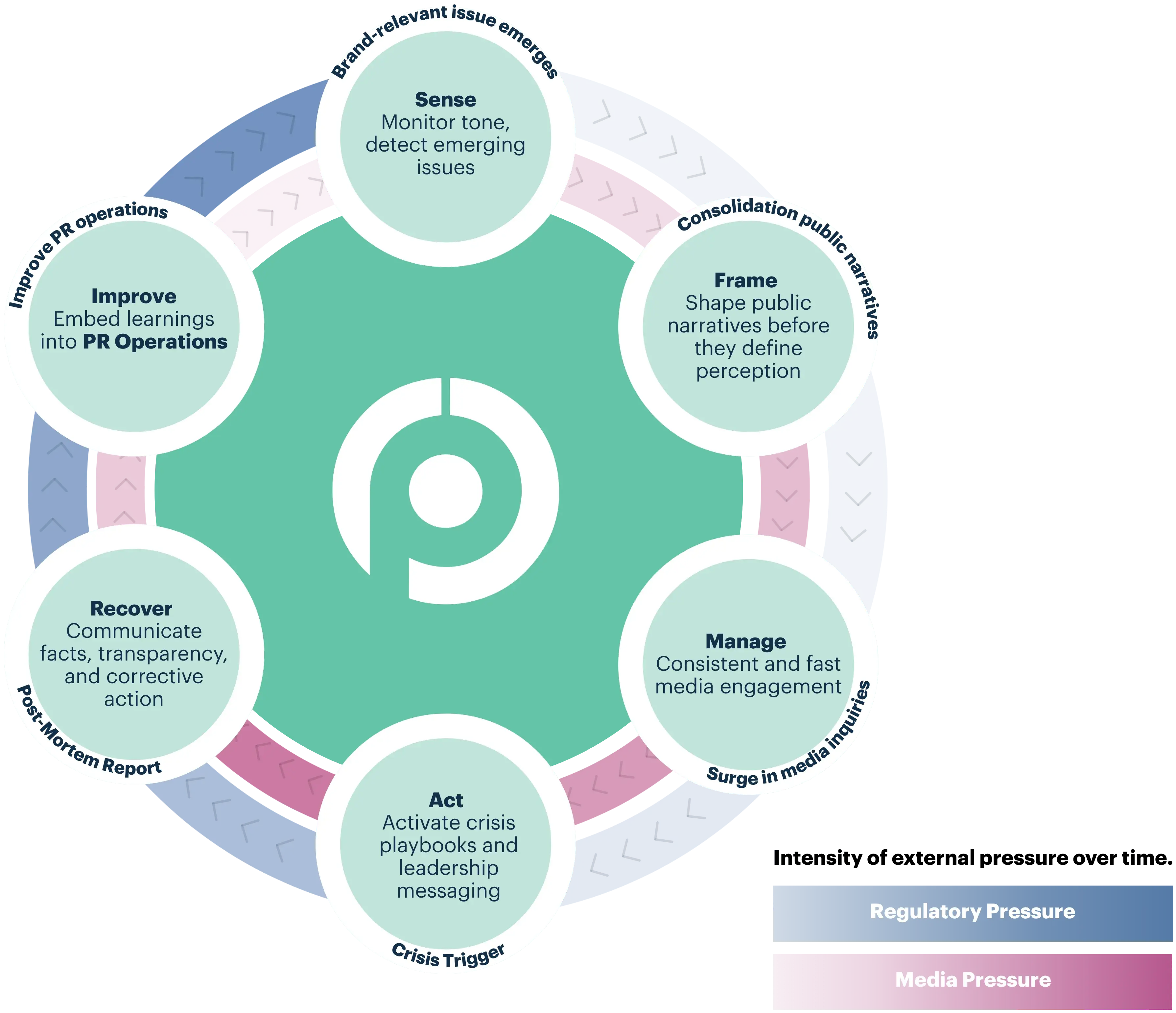Airports live in a world few other brands can imagine; a world that never sleeps. Every hour brings new passengers, new partners, new stories…and new risks. For airport communication professionals, reputation is the runway everything else depends on. And with 63% of a company’s market value driven by reputation, that runway has never been more critical. Yet in a space where operations never pause, audiences span continents, and even routine delays can make global headlines, how do you measure whether your PR efforts are working? How do you know if you’re leading the conversation, or just reacting to it? Let’s break it down. |
The reality of aviation & airport PR: complexity at cruising altitude
Few industries operate under more scrutiny than aviation. Every update, from terminal upgrades to tarmac delays, can become a headline within minutes.
Airport PR teams juggle:
- Multiple locations – often spanning airport groups, routes, and partner hubs.
- Multiple teams – communications, operations, customer service, legal, and safety.
- Multiple brands – airlines, regulators, ground handlers, and retail partners.
- Multiple audiences – media, passengers, investors, local communities, and governments.
And all of this happens in a 24/7 media environment, where one misstep in messaging can snowball across time zones before dawn.
As Bart Verhulst, Co-founder of Presspage, put it during our recent Digital PR for Airports roundtable:
“Airport communicators are prepped for any other market thrown at them. If you can manage PR in aviation, you can manage it anywhere.”
This global, high-velocity context is exactly why benchmarking, knowing where you stand, matters. Because when the heat is on, you can’t fix what you can’t measure.
Why benchmarking matters (and how to start doing it)
Benchmarking is about creating a clear, data-driven foundation for decision-making in one of the most complex communication ecosystems on earth.
A few reasons it matters more than ever:
- The media environment is accelerating.
News breaks in seconds, not hours. You need to see performance patterns, what works (and what doesn't), fast. - Generative search has changed discoverability.
Platforms now reward fresh, authoritative content. Regular publishing is now visibility insurance. - Stakeholder expectations are sky-high.
Airlines, regulators, and passengers expect transparency and data-backed communication. Benchmarks give credibility to what you report internally and externally.
The numbers that define strong airport & aviation PR
Presspage benchmark data from 17 global airports gives us a reality check on what “good” looks like in digital PR performance:
|
Metric |
Median |
Top Performers |
|
Publishing activity |
77 press releases per year |
Up to 106 |
|
Returning visitors |
64.6% of all newsroom traffic |
78% |
|
Average readers per story |
1,667 |
6,000+ |
If you’re publishing less than once a week, struggling to bring readers back, or unsure who’s reading what, that’s your starting point.
But these numbers don’t exist in isolation. They’re tied to quality of storytelling, strategic timing, and the ability to connect operations to narrative.
As Bart puts it:
“Authority online isn’t about shouting louder, it’s about showing up consistently with stories that matter to your stakeholders.”
Who’s getting it right: airport comms that lead the way
The best airport PR teams don’t wait for news to come to them, they create it. Here’s how leading airports are turning everyday operations into communication wins:
1. Real-time news hooks:
Heathrow Airport
When Heathrow reopened a routine gate after refurbishment, the story could’ve been a footnote. Instead, their team tied it to “the busiest weekend since pre-pandemic”, turning an operational update into a national signal of competence.
Takeaway: Every operational milestone can be a reputational one if framed in the right context.
2. From data to narrative:
Dubai International Airport
Dubai reframed quarterly passenger data into a story about economic momentum and global recovery. What could have been dry traffic stats became a reflection of national resilience.
Takeaway: Numbers mean little without narrative, show why the data matters.
3. Localised stories:
Dallas Fort Worth (DFW)
DFW launched a regional campaign showing the airport’s role in job creation and the North Texas economy, earning wide local coverage and goodwill.
Takeaway: National reputation is built on consistent local relevance.
4. Proactive disruption comms:
Heathrow Airport (again)
Ahead of a major snowstorm, Heathrow activated pre-approved communication templates, alerting passengers early, explaining contingency plans, and updating in real time. The result: less frustration, more praise.
Takeaway: Preparedness earns patience when disruption hits.
5. Innovation storytelling:
Zurich Airport
Zurich invited lifestyle journalists to meet their new service robots, “Zulu” and “Charly.” The story went viral on social, reinforcing Zurich’s reputation for innovation.
Takeaway: Local voices make innovation relatable and shareable..
6. Transparency & trust:
Munich Airport
Munich reframed a 20% reduction in nighttime noise as a sustainability milestone, not an operational update. The result: national coverage that positioned them as a responsible industry leader.
Takeaway: The best PR stories show progress, not perfection.
Across all six of these stories, one principle stands out: the fastest-moving teams are the ones who prepared in advance. Which leads us to the next challenge, turning everyday readiness into true crisis resilience.
From everyday PR to crisis readiness
Airports face unique operational risks, weather, strikes, technical incidents, and security issues that can ignite headlines within seconds.
And while you can’t predict every crisis, you can predict how the life cycle of one will unfold.
Bart Verhulst calls this the Crisis Lifecycle Framework™, a model built from years of working with airports worldwide.

Each phase offers a chance to protect reputation or lose control of it.
1. Sense
Monitor tone and detect early signals. Use social sentiment, partner alerts, or flight data anomalies to spot issues before they erupt.
2. Frame
Shape the narrative before others define it. During COVID-19, Singapore Changi positioned itself as a health and safety leader, not a victim of disruption, a textbook example of proactive framing.
3. Manage
Coordinate fast, consistent media engagement across all partners and spokespeople. Frankfurt Airport did this effectively during strike actions, ensuring everyone, from unions to airlines, spoke with one voice.
4. Act
Execute your crisis playbook decisively. Heathrow suspended operations after a drone sighting, but reframed the story around passenger safety, not loss of control.
5. Recover
Once the storm passes, communicate corrective actions transparently. Schiphol earned back public trust post-COVID by openly addressing staffing shortages and explaining its recruitment drive.
6. Improve
Feed learnings back into your operations. Changi now integrates health dashboards into its PR monitoring; Heathrow added 24/7 sentiment tracking after its drone incident.
The message is clear: readiness isn’t a one-time plan; it’s a living process that gets sharper with every event.
Issue management: Reputational insurance
Crisis response protects your brand. Issue management builds it.
Every airport faces recurring topics: sustainability, safety, noise, growth, jobs, and innovation. Each of those topics has sub-issues beneath it. The best communicators map them out, decide their stance in advance, and prepare messaging before the headlines hit.
That preparation means your team never scrambles for approvals mid-crisis. You’ve already agreed on what you stand for and how you’ll say it.
“It’s no use designing a crisis plan in isolation,” Bart explains. “You need a team-wide approach where pre-approved statements and stances are ready long before you need them.”
Done right, issue management turns risk into opportunity, a chance to speak early, earn trust, and lead the conversation.
Building a smarter PR operation
Even the best teams can’t execute fast if their tools slow them down.
The average airport comms team uses 7–10 disconnected systems: email, shared drives, spreadsheets, media databases, translation tools, social schedulers and more, each adding friction when minutes matter.
A modern, digital PR ecosystem changes that.
How Presspage helps airport communicators move faster
Presspage was designed specifically for PR teams active in high-stakes environments like aviation, where speed, accuracy, and consistency define success.
With one secure platform, airport & aviation PR teams can:
- Publish news and updates in real time across newsrooms, wire, and social channels.
- Reach out from a single hub to pre-built media lists and stakeholders.
- Connect with journalists via tracked media inquiries, ensuring every question is logged, delegated, and answered consistently.
- Discover performance analytics with clear dashboards and benchmarks, and compare how your PR efforts stack up against the competition.
“Airports don’t have time for tool chaos,” Bart says. “The right platform keeps your comms agile, in peacetime and in crisis.”By removing technical bottlenecks and silos between PR and marketing analytics, teams gain the independence to act fast, and the insight to prove impact.
Bringing it all together
Benchmarking shows you where you stand.
Real-time storytelling shows you what works.
Crisis readiness ensures you stay in control when it matters most.
For airport communication leaders, mastering all three is what separates reactive comms from resilient reputation. So, take a moment to look at your operation:
- Are you publishing consistently enough to stay visible?
- Do you know which stories perform, and why?
- Can your team act fast, aligned, and with confidence when disruption hits?
If not, you’re not alone, and you’re not without options!
Presspage helps airport and aviation PR teams manage the entire communications lifecycle, from everyday storytelling to crisis-ready response, in one integrated platform. It gives you the control to publish instantly, the structure to coordinate complex teams and stakeholders, and the insight to prove the impact of your work.
Because in an industry that never sleeps, your newsroom should never stand still.
Ready to strengthen your airport’s communications?
Discover how Presspage empowers airports worldwide to protect reputation, streamline collaboration, and lead the narrative.






